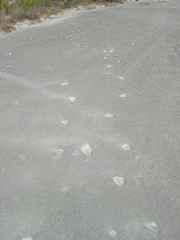There is a Brief Communications Arising (Nature 01 December 2005) associated with this document.
 Could this be a footprint from 40,000 years ago?© Silvia Gonzalez
Could this be a footprint from 40,000 years ago?© Silvia GonzalezResearchers think they may have found footprints in southern Mexico that mark the oldest evidence for the presence of humans in the Americas.
The impressions, preserved in volcanic ash outside the city of Puebla, have been dated to about 40,000 years ago, beating the oldest accepted evidence of humans in the Americas by some 25,000 years. If proven, the prints would lend support to controversial theories that people reached this land much earlier than previously thought.
The researchers themselves say more work needs to be done to confirm that they have found the mark of human steps. "I believe they are footprints," says geoarchaeologist Silvia Gonzalez of Liverpool John Moores University, UK, who is originally from Mexico. "But we are being cautious, as we need to do more work."
Gonzalez reported the discovery on 4 July at the Royal Society's Summer Science Exhibition in London.
Long-distant runners
 A path of 'prints' in the ash field of an ancient volcanic eruption.© Silvia Gonzalez
A path of 'prints' in the ash field of an ancient volcanic eruption.© Silvia GonzalezThe team first stumbled on the prints in the summer of 2003 while hiking between archaeological sites near the dried bed of Valsequillo Lake. They found an ash field peppered with more than 200 impressions that seem to be footprints from several people, including children, along with birds, cats, dogs and species with cloven feet. Gonzalez thinks they might have been fleeing an eruption from the nearby Cerro Toluquilla volcano.
The prints are plainly exposed and in an area that sees traffic in everything from miners who quarry the ash to recreational cyclists. Some worry that human interference, along with heavy rains, might have acted to make the impressions that now look like footprints.
Thomas Higham of the University of Oxford, UK, used radiocarbon dating on shells in sediments just above the layer of ash and found they were about 40,000 years old.
Early arrival
The prevailing theory is that people first migrated from northern Asia between 15,000 and 10,000 years ago, crossing to America over a land bridge at the Bering Strait. But controversial genetic analyses of Native American populations indicate that some immigrants may have arrived much earlier than that, up to 40,000 years ago. That predates the ice age that held much of North America in its grip some 20,000 years ago.
No direct evidence has been found for this early arrival. The oldest archaeological evidence is found in Chile's Monte Verde ruins, which contains signs of campfires and other clues of human occupation from about 14,500 years ago.
Debate continues about what the marks really represent. "I've seen them up close and personal, and I don't think they are footprints," says Paul Renne, a geochronologist at the University of California, Berkeley. Renne is keen for the team to find further evidence of human occupation that might shore up its claim.
ADVERTISEMENT
Bruce Latimer, a human anatomist at the Cleveland Museum of Natural History in Ohio who helped identify some 3.5-million-year-old Laetoli footprints in Tanzania, agrees that caution is necessary. He says that human prints are usually so distinctive they are hard to miss. "I have not seen them. But if you have to equivocate, it is probably not human."
The team plans to excavate the site in the Valsequillo Lake basin early next year, in an attempt to uncover other footprints or signs of human life. Late last month, the British Natural Environment Research Council gave the Gonzalez team a US$370,000 grant to continue their work.
